Seduced by low inflation
Monday, June 16th 2014, 7:11AM
by Harbour Asset Management
Global bond yields continue to fall
One of the biggest surprises in markets in 2014 has been the fall in global bond yields.
As the US Federal Reserve (the US Fed) struggles to gauge pressures in the US labour market, attention has turned elsewhere. With US inflation still near post GFC lows, the market has become seduced by the idea that US interest rates will stay lower for longer.
At the beginning of the year, the US 10 year yield was at 3% and most economists picked yields to rise further towards 3.50% by the end of 2014.
With US the 10 year yield back below 2.50%, many investors are asking why?
Through the first few months of the year the fall in global bond yields could be explained by a number of factors that seemed relatively temporary: a weak patch of weather-affected US economic data; emerging market wobbles; and a flight to safety as the Ukraine conflict began.
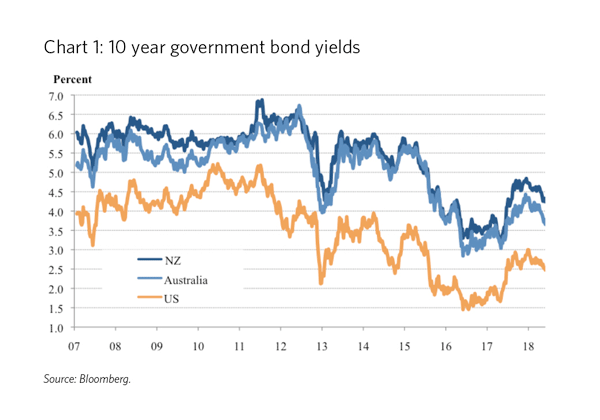
Source: Bloomberg.
However, as we have progressed through the year, the drivers of low bond yields have changed.
- First, central bankers have wondered aloud about whether official interest rates will ever need to return to pre- GFC leaves. New York Fed President, Bill Dudley, and outgoing Bank of England deputy governor, Charlie Bean, are the latest to share these thought bubbles.
- Second, and more importantly, given the fall in US labour market participation, the US Fed seems to have lost faith in the unemployment rates as a measure of spare capacity, dropping it as a specific measure used to guide the market on when it will finally lift official overnight interest rate.
This leaves inflation as key variable to watch.
In December 2012, the US Fed introduced the so-called ‘Evans Rule’ that specified that it would maintain its loose policy stance so long as projected inflation remains below 2.5%. With the Federal Reserve’s favoured measure of inflation – the Personal Consumption Expenditure (PCE) deflator – just a little over 1%, the market has become seduced by the idea that US interest rates will stay lower for longer.
Reinforcing this, the European Central Bank (ECB) has signalled that it is likely to provide further monetary stimulus at its June policy meeting to ward off the threat of deflation.
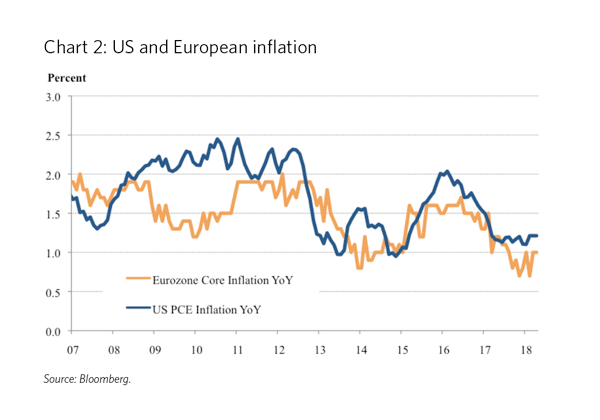
The challenge of measuring spare capacity
However, markets can be fickle, and there is chance that the focus swings back to improvements in the US labour market.
New research by the Richmond Federal Reserve Bank argues that the unemployment rate is still a good guide, providing similar signals to a range of other measure of labour market capacity.
The data sources and maths are comprehensive, but the logic is quite simple. In a nutshell, the vast majority of people out of the US workforce do not want a job (Chart 3) and the historic probability of those people finding work is so low that a probability weighted measure of non-employment gives a very similar signal to the good old fashioned unemployment rate.
In other words, the fall in participation rate is not hiding a huge pool of potential labour ready to return to the economy and take pressure off inflation.
The paper is due to be formally published in June. It has already started to attract the attention of policy makers according to the minutes of the Fed’s April 29-30 meeting.
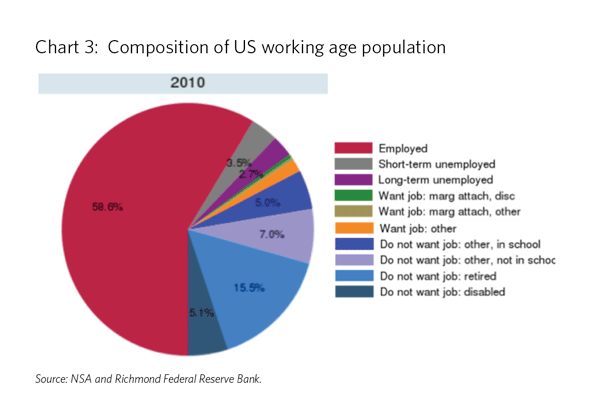
Waiting for the RBNZ’s Monetary Policy Statement
In New Zealand, bond yields have been dragged down by these global developments and intensified focus on low inflation.
This follows the recent theme of global fixed interest investors being drawn to New Zealand in a search for yield. The NZ 10 year government bond yield fell around 15 basis points to 4.25%, and the NZ 2 year swap rate fell 10 basis points to around 3.90%.
Looking forward, the main domestic driver of NZ bond yields is likely to be the RBNZ’s upcoming June Monetary Policy Statement. Since its last announcement in March, we would categorise the main economic news as follows.
Weaker than expected:
- NZ Q1 CPI was lower than expected at 1.6% year on year.
- While a correction from lofty levels was expected, NZ commodity prices have probably fallen back more quickly than anticipated in March.
- Trading partner growth, including Australia, was a touch weaker than expected.
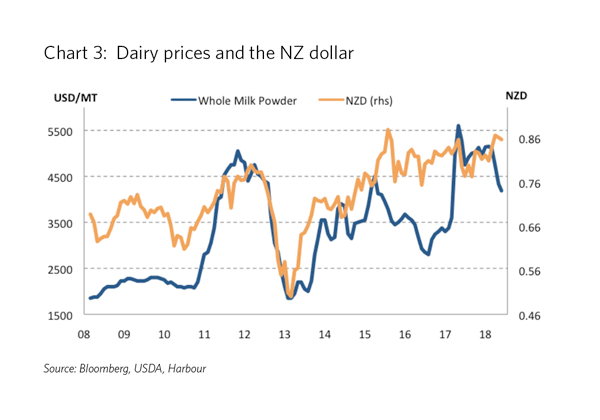
Broadly as expected:
- The NZ dollar is broadly unchanged since the March RBNZ statement, having fallen from elevated levels after Graeme Wheeler’s hints about intervention.
- Both business and consumer confidence have fallen slightly from very elevated levels, which the RBNZ would have anticipated given their OCR hikes. These indicators still point to 4-4.5% GDP growth.
- The housing market has cooled slightly, consistent with the LVR restrictions.
Stronger than expected:
- Fierce mortgage market competition has helped insulate fixed rate mortgage borrowers from the OCR hikes so far, as illustrated by average effective mortgage rates only rising 12 basis points following 50 basis points of OCR hikes. This suggests the RBNZ needs to do more to get bang for its buck.
- Net migration has increased to new record highs, with a sharp fall in departures to Australia, putting further pressure on domestic resources.
- The NZ Budget in mid-May provided more stimulus than expected, with the government shaving its surplus forecasts between 2016 and 2018 as new spending programs were announced (Chart 4).
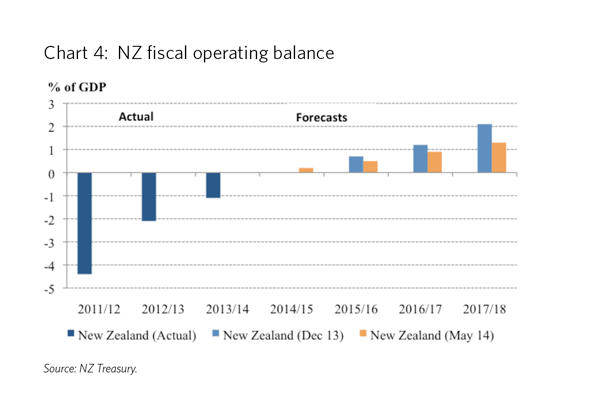
So, on balance, we consider that the economic data supports the view that the outlook for the NZ economy still looks relatively strong, consistent with the need for the RBNZ to continue removing stimulus over 2014 and 2015. With the NZ two-year swap rate having fallen 15 basis points since the last Monetary Policy Statement, we see scope for yields to correct higher if the RBNZ broadly reiterates its position in the June Statement.
Similarly, at the long end of the yield curve, we continue to see the medium-term risk skewed towards yields rising. While current US inflation remains very subdued, global yields may remain low for a period. However, with the underlying economic momentum intact, we would expect the market to eventually refocus on the US economy using up its spare capacity, with the prospect of the Fed Funds rate rising in early 2015.
Christian Hawkesby is a Director and Head of Fixed Interest & Economics at Harbour Asset Management
IMPORTANT NOTICE AND DISCLAIMER
The New Zealand Fixed Income Commentary is given in good faith and has been prepared from published information and other sources believed to be reliable, accurate and complete at the time of preparation but its accuracy and completeness is not guaranteed. Information and any analysis, opinions or views contained herein reflect a judgement at the date of preparation and are subject to change without notice. The information and any analysis, opinions or views made or referred to is for general information purposes only. To the extent that any such contents constitute advice, they do not take into account any person’s particular financial situation or goals, and accordingly, do not constitute personalised financial advice under the Financial Advisers Act 2008, nor do they constitute advice of a legal, tax, accounting or other nature to any person.. The bond market is volatile. The price, value and income derived from investments may fluctuate in that values can go down as well as up and investors may get back less than originally invested. Past performance is not indicative of future results, and no representation or warranty, express or implied, is made regarding future performance. Bonds and bond funds carry interest rate risk (as interest rates rise, bond prices usually fall, and vice versa), inflation risk and issuer credit and default risks. Where an investment is denominated in a foreign currency, changes in rates of exchange may have an adverse effect on the value, price or income of the investment. Reference to taxation or the impact of taxation does not constitute tax advice. The rules on and bases of taxation can change. The value of any tax reliefs will depend on your circumstances. You should consult your tax adviser in order to understand the impact of investment decisions on your tax position. To the maximum extent permitted by law, no liability or responsibility is accepted for any loss or damage, direct or consequential, arising from or in connection with this document or its contents. Actual performance of investments managed by Harbour Asset Management Limited will be affected by management charges. No person guarantees the performance of funds managed by Harbour Asset Management Limited.
Important disclaimer information
| « Not the New Year markets we were expecting | Inflation creeping back into the global economy? » |
Special Offers
Comments from our readers
No comments yet
Sign In to add your comment
| Printable version | Email to a friend |









